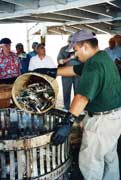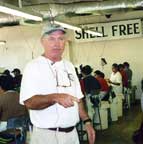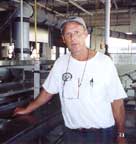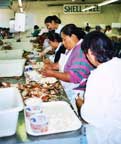
|
|
 |
|||||||||
|
Volume 13, Issue 39 ~ September 29 - October 5, 2005
|
|||||||||||
In Maryland’s crab picking industry, everything’s used, nothing’s wasted This season, as many as 1,000 bushels of crabs a day are processed at the Clayton Company’s Choptank River plant story and photos by M.L. Faunce Marylanders love their crabs, but we’ve loved like Shakespeare’s Othello, not wisely but too well. Mountains of shell discarded after a crab feast tell the story of us as consumers, our insatiable appetite for crabs, our habits of consumption and waste. In Maryland’s crab picking industry, it’s a different story. There, everything’s used, nothing’s wasted. We followed the division of the whole crab into a product greater than the sum of its parts at the J.M. Clayton Company in Cambridge, which calls itself the “oldest working crab processing plant in the world.” Founded in 1890 by Captain Johnnie Clayton and today operated by great-grandsons Jack, Joe and Bill Brooks, Clayton Company is one of some 25 crab processing plants in 21st century Maryland, most on the Eastern Shore’s Dorchester County. The number is down sharply from some 60 plants in the 1980s and many more in earlier years. Maryland seafood processing plants may be a fading industry, but not because of any deficit on the part of owners and employees. The packing house floor is a whirlwind of energy, vitality and sheer determination. From Live to Steamed Within the hour after Atlantic blue crabs arrive at the dock, their division into delicious and useful products begins. Self-employed crab potters and trotliners off-load their booty of beautiful swimmers onto Clayton’s prime Cambridge Choptank riverfront dock. There a Clayton worker culls and grades them, setting aside the best for the “table trade.” Crabs at least five and three-quarters inches point to point are destined for restaurants, where they’ll be steamed and devoured in copious quantity. Crabs with no “live trade” market — females and legal, smaller male crabs — get cooked. From bushel baskets (imported, incidentally from Little Rock, Arkansas) stacked on the dock, it’s a short ride on a short pier, a momentary reprieve before crabs are emptied into steel baskets the size of an SUV. Clayton’s two four-by-six-foot vats each hold 400 pounds of squirming, scrapping crabs. The fight soon will be steamed out of them as they’re plunged into 250-degree steam for seven minutes. At Clayton’s on a mid-summer’s day, 350 bushels of crabs will be so handled. In late summer and fall, when many say crabs are at their fattest and the table trade slackens, a staggering 1,000 bushels of crabs a day are processed at the Choptank River plant.  Hand Picking Hand PickingCrabs are in good supply this time of year — for this year at least — and a bumper crop reaches the docks. It’s the pickers who are in short supply, as Marylanders forsake a trade that’s seasonal, monotonous and painstaking. Emergency legislation sponsored by Sen. Barbara Mikulski saved the day for Maryland crab processing plants, and Congress approved her bill allowing temporary visas for guest workers from Mexico to fill empty crab-picking and -packing jobs. With guest visa issues resolved for this year and next, all hands are at work. Crab picking is a trade ruled by women; traditionally, men crack only the claws. The women’s hands are swift and sure, moving seamlessly as if their fingers flow into the action of their knives. Their minds and bodies seem detached, so concentrated is the automation. They move quicker than the eye, slicing off the crabs’ swimming legs, cross-sectioning and dissecting the body. Most work barehanded, but some wear a single rubber glove. At Clayton, pickers must produce a minimum of 18 pounds of crabmeat a day. Crab pickers are paid $2.25 per pound of meat picked. They get no benefits. Experience counts when it comes to picking, and the best, like 53-year-old Georgia ‘Sissy’ Cephas, a picker for 25 years, can race the clock through a bushel of crabs piled high in front of her. Each day, she picks “30, 40 even 50 pounds,” says Jack Brooks. Sissy and each of her sister-pickers develop their own style of picking. Speed as well as style follow experience. Clayton’s Epicure pound containers lined before the pickers tell the hierarchy of crabmeat. From top to bottom, it’s jumbo lump, lump, special and claw, and each crab contributes some to each pot. Each picker is assigned a number that’s marked on each bottom of the container she picks. That’s how her pay is counted, and if you find too much shell, you can complain that number so and so did not carefully add only crab and no shell to her product. By house rules, pickers break each hour and a half. They stretch their backs and fingers, then carry their cans and plastic cups of crabmeat across the packing house to the inspection station. At each mandatory break, pickers wash their hands and sanitize their trays and knives.
Next the containers are sealed. A plastic lid is clapped on plastic tubs of fresh crabmeat meant to be eaten within days. Metal cans of crabmeat will be, as the can reads, “pasteurized to retain its quality.” But first they’re lidded, one by one, in an ancient press at a top speed of 30 to 40 a minute, depending on the speed of the person pressing the lever. Canned crab meat will then be pasteurized by cooking at 190 degrees for two hours. Stored at 38 degrees — not frozen — as the can advises, it’s good for six months to a year. Joe Brooks says he’s sampled pasteurized crab meat canned and refrigerated years ago; it was still good. He prefers pasteurized. “It’s always as fresh as the day it was caught.” Finally the sealed containers are packed in layers of ice inside a cardboard box for shipping. They’ll be trucked tonight and delivered tomorrow in Baltimore, Washington and southern Pennsylvania, where one of Claytons’ big customers is Giant Foods, Pennsylvania. It’s true handwork every step of the way, and all done basically the same way since 1890. Today, though, Brooks says the company complies with rules set by 23 separate regulatory agencies. Nowadays, Maryland crab meat is a high-end product, and hand-picking adds to the gourmet label and the price tag. Its taste is described as sweet, and, yes, it’s possible to taste the difference. “Imported Portunus pelagicus crab is a little larger on average than our Callinectes sapdius and has a much deeper body, allowing a larger lump and less shell,” explains Noreen Eberly, Maryland’s director of seafood marketing. “The crab meat is very white, due to processing and the addition of sodium acid pyrophosphate. Our crab meat is more of a cream color that includes the flavorful fat and no additives or preservatives. “Side by side, the imported looks prettier,” Eberly says, “but Maryland crab meat tastes better. We have done consumer taste-test panels in Maryland, Virginia and North Carolina that testify to that.”
Can a Machine Pick Crab? As the picking and packing houses ramp up for the October and November deluge of crabs, even the 50 pickers at Clayton’s aren’t enough to keep up. When crabs outnumber pickers, the slack is taken up by a picking machine developed in the 1970s when the industry first felt labor shortages. The efficient machine can top even the best hand-picker, unshelling 180 crabs a minute for 2,200 pounds — that’s 400 to 500 bushels — a day. The mechanized process carries crabs by a system of conveyor belts. First, trays of cooked crab are softened on a steam table leading to an airbag-like mechanism that shakes the crabs violently for a second or two, releasing meat from shell. The meat is deposited onto a belt and inspected for shell by human eyes. So a machine can pick crab. But even the best machine can’t preserve the lovely great chunks that make lump crab meat — a 50-50 combination of special and lump — worth $18 a pound and jumbo lump — $23 at Clayton’s plant. A crab-picking machine breaks up the lumps when it shakes out the meat, which is sold as flake meat under the special label for $13 a pound.
But there’s no way even the best pickers can keep up with all the claws. So at this time of year the Harris machine goes to work. Whole claws are fed through a reel that washes them into a hammer mill, where they’re broken up. Next, the salinity in a salt-water bath makes the meat float and the shell sink. The meat overflows onto a perforated belt, where it’s rinsed with fresh water, inspected for shell then drained and packed. Machine picked claw meat sells for $10 a pound on site. Waste Not, Want Not There’s more shell than meat in any crab, and all those thousands of pounds of crab leave potentially huge waste piles. But in this business, nothing goes to waste. Crabs have eight swimming legs, about which Brooks says, “you can’t make a meal from them, but they contain a lot of meat, protein and flavor. Another machine goes to work making mincemeat of those legs, the picked-over shells the back shell and the fat. Baader meat, so named for the German-invented machine that extracts remainder meat for a flavoring paste, is sold in five-pound packs to processors and restaurants for soups and filler for crab products and seasoning.
There it’s processed into Chesapeake Blue, weed-free compost for lawns, vegetable gardens, flowerbeds, shrubs and tress, fall-planted bulbs and potted plants. “Crab shells are rich in nitrogen, but they need the addition of sawdust to balance carbon and nitrogen,” explains Pat Condon, president of the 12-year-old Earth Services. “When the two are combined, microorganisms thrive. Temperatures reach 160 degrees, and all the bad bacteria is killed. Six or eight months down the road, we’ve go an odor-free, shelf-stable compost.” New Earth Services produces 1,000 tons of Chesapeake Blue a year from 1,000 tons of crab shell and 1,000 tons of sawdust. Loved well and sometimes wisely, blue crabs give us their all. The Clayton Company of Oxford welcomes tours of 10 or more by appointment. $5 per person: 800-652-6931; www.jmclayton.com
|
|||||||||||
|
|
|||||||||||
|
© COPYRIGHT 2004 by New Bay Enterprises, Inc. All rights reserved. |





 About the Author
About the Author